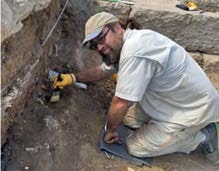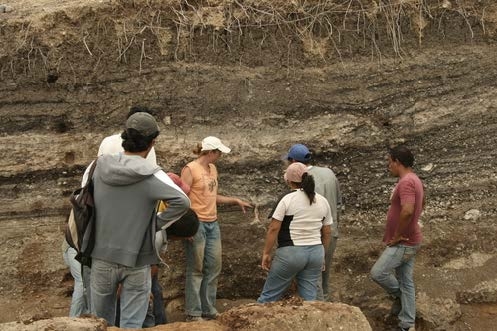Past Events
Interested in Cotsen events? Sign up for our mailing list.Speaker: Dr. Dorie Reents-Budet, Boston Museum of Fine Arts

This talk employs distributional patterns of pottery, determined by archaeology, ceramic typology, artistic style and nuclear chemistry, to discern Classic Period (250-850 CE) economic interaction spheres among the Maya. The research points to the crucial role played by cotton production in the political economy of the Maya and throughout ancient Mesoamerica, the ceramic distributional patterns coinciding with configurations of alliance noted in other archaeological data.
Contact Matthew Swanson
Email mswanson@ioa.ucla.edu
Phone
Speaker: Dr. Philippe Walter, Sorbonne Universités, Université Pierre et Marie Curie
The precious character of the Cultural Heritage artifacts and their uniqueness imply particular cautions and require instruments, which may give the maximum of information directly on the objects, in-situ in the museums or in the archaeological sites. The implementation of new analytical tools, including mobile instruments, allows a deep insight on the archaeological and artistic materials.
We will show the performances of different new mobile instruments (X-ray fluorescence and X-ray diffraction) we built recently in the laboratory to allow in situ characterization of materials, for instance on prehistoric rock art paintings in France or marble sculptures from Greece (Delphi) and Tunisia (Bardo National Museum), alteration products and modes of preparation of different pigments. XRF imaging – in which the surface of an object is scanned with a focussed X-ray beam to obtain elemental distribution images – and hyperspectral imaging can reveal significant new information on the antique polychromy.

Contact Matthew Swanson
Email mswanson@ioa.ucla.edu
Phone
Speaker: Dr. Jorrit Kelder, University of Oxford
This presentation aims to provide an overview of the earliest contacts between the Greek (Mycenaean) world and Egypt, between ca. 1600 BC and 1100 BC. By highlighting a number of objects that have been found in Egypt and the Aegean, this paper proposes that the earliest contacts between these two regions may have started in the context of long-distance trade in precious metals (with silver coming from the Aegean, and gold exported from Egypt). From the 14th century BC onwards, these early trading encounters developed into a much closer, 'special relationship', which involved the exchange of goods, plants, and possibly mercenaries.
Contact Matthew Swanson
Email mswanson@ioa.ucla.edu
Phone
Speaker: Dr. Thomas Schneider, University of British Columbia
The First Intermediate Period has presented archaeology and historiography with significant epistemological problems. Gaps in the evidence available to us and the uncertainty about how to interpret a variety of material and textual sources, have as much led to widely different views as modern paradigmatic shifts, depicting the
FIP either as a time of crisis or to the contrary, a time of regional innovation. This paper will look at the methodological problems with which archaeologists and historians of the FIP are faced today. What can we know today and what are possible avenues of future research?
Contact Matthew Swanson
Email mswanson@ioa.ucla.edu
Phone
Speaker: Dr. Cathy Costin, California State University, Northridge
Although some have suggested that North Coast ceramics are characterized by a stable technological style over thousands of years, evidence indicates that several aesthetic and technological styles "coexisted" with one another; they waxed and waned in popularity depending in large measure on the social and political environments in which ceramics were made and used. In this presentation, I consider how choices made in the production of decorated ceramics on the North Coast of Peru influenced and were influenced by the use of these vessels as information technology. Choices about forming, decorating, and firing processes conditioned how pottery looked and felt and affected the efficacy and efficiency of wares used to convey information about individual identity, social group affiliation, and important ideological concepts. I discuss those technological and aesthetic choices that relate specifically to appearance within their broader sociopolitical contexts, focusing on how pottery was used to encode symbolic messages and visually transmit significant messages.
Contact Matthew Swanson
Email mswanson@ioa.ucla.edu
Phone
Speaker: Dr. Owen Doonan, California State University, Northridge
 Ancient Sinop was the crossroads of the ancient Black Sea, which has been itself described by the distinguished historian Georges Bratianu as the "Turntable of Eurasia."
Ancient Sinop was the crossroads of the ancient Black Sea, which has been itself described by the distinguished historian Georges Bratianu as the "Turntable of Eurasia."
Owen Doonan has led an interdisciplinary archaeological expedition to the Sinop region since the mid-1990s and through that research program has established a basic sequence of settlement, economic and cultural history in the region. The research has significant implications for the understanding of: (1) the entanglement of colonial and indigenous communities (ca. 630-200 BC); (2) the establishment of Roman infrastructure (1st – 3rd centuries AD) in a remote region of Asia Minor (the Roman term for modern Turkey); (3) the impact of the establishment of Constantinople (modern Istanbul) as the seat of a world empire, ca. 330-600 AD; and (4) the mysterious collapse of the flourishing Byzantine rural system ca. 650 AD.
Starting in the summer of 2015 Dr. Doonan's team has initiated a long-term program of excavations at Sinop kale, the heart of the ancient port and colony. He will speak on the new excavations in the context of the systematic survey and broader cultural and economic trends in the region.
Contact Matthew Swanson
Email mswanson@ioa.ucla.edu
Phone
Speaker: Dr. Heather Miller, University of Toronto
Archaeological interest in technological change focuses on both invention and production by craftspeople, and on social issues related to adoption of new technologies. We recognize that technological change involves both motivations and mechanisms for change, with respect to both the invention and innovation/adoption ends of the spectrum. The possible motivations and mechanisms for the development and spread of the faience materials found across western Eurasia provides an excellent third millennium BCE case study.
A bewildering assortment of materials utilizing siliceous pastes were used to make small objects such as figures, beads and containers, in ancient Egypt, Mesopotamia, the Indus Valley, the Mediterranean, and regions beyond and between. From very early beginnings in the sixth millennium BCE or earlier in some regions, the assortment of these materials reached great diversity of production technique and material in the third and second millennia BCE, with much less diversity of appearance. In places where these materials have seen more analytical study, such as Egypt and the Indus Valley, similarities but also striking differences occur in the regional assortments of materials and techniques employed to produce quite similar appearing materials, used to make objects clearly belonging to the local corpus of style and topic. The Indus Valley case will be the special focus of my talk, where we must speak of it as a talc-faience complex due to the entwined nature of these materials in the Indus Civilization corpus.
What was involved in the spread of these materials and their manufacture? Technological change includes both new ideas or products, and the adoption of those new ideas or products, both invention and innovation (sensu Torrence and van der Leeuw 1989). For the example of the Indus case, can we find clues to the social process involved in the innovative development of these materials from analysis of the objects and their production?
Contact Matthew Swanson
Email mswanson@ioa.ucla.edu
Phone
Speaker: Dr. Emily Lindsey, University of California, Berkeley

For decades a debate has raged over the relative contributions of human activities and environmental change in driving the extinction of most of earth’s large mammals near the end of the last ice age. Recent research by our group in South America draws on archaeological, paleontological, paleoclimatological, quantitative modeling, and geochemical studies in order to investigate how these extinctions progressed through space and time across the continent. These studies reveal complex synergistic interactions between climatic and anthropogenic pressures, and highlight the need for integrating multiple regional-scale analyses in order to understand how large-scale extinction events transpired in the past, and how they are likely to proceed in the context of ongoing climate change and growing human impacts today.
Contact Matthew Swanson
Email mswanson@ioa.ucla.edu
Phone
Speaker:
Alexis Boutin, Associate Professor of Anthropology, Sonoma State University
Since 2008, the Dilmun Bioarchaeology Project has been studying and publishing the materials from Peter B. Cornwall’s 1940-41 expedition to Bahrain and eastern Saudi Arabia, which now reside in the Hearst Museum of Anthropology at UC Berkeley. This multi-disciplinary team is adding to anthropologists’ understanding of how life was experienced and death commemorated in ancient Dilmun (ca. 2050-1800 BCE). In this talk, Dr. Boutin will explore how human skeletal remains and associated grave goods can reveal transformations in identity (e.g., gender, age, and physical ability) across the life course. She will also explain how experimenting with alternative modes of interpretation can improve bioarchaeological praxis and communicate effectively and accessibly with diverse audiences.
Contact Matthew Swanson
Email mswanson@ioa.ucla.edu
Phone
Speaker:
Dr. Ian Hodder, Stanford University

Contact Matthew Swanson
Email mswanson@ioa.ucla.edu
Phone
- ‹ previous
- 6 of 7
- next ›


